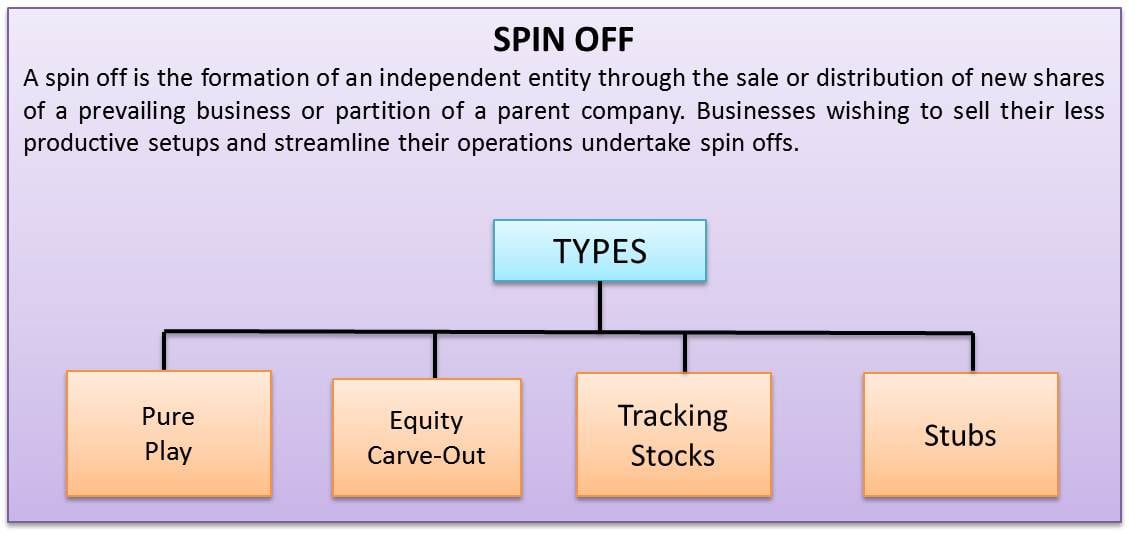Definition Of Spin Off
A spin off is the formation of an independent entity through the sale or distribution of new shares of a prevailing business or partition of a parent company. It is a type of divestiture. Businesses wishing to sell their less productive setups and streamline their operations undertake spin-offs. A company may wish to spin off its mature business units, which are experiencing no growth and is stagnant.
This permits the company to focus on products with higher growth prospects. This benefits the spun-off business as they hold a higher worth being an independent entity rather than a part of a larger business. The spin-off is thereby considered to be one of the most profitable forms of corporate restructuring.
After understanding the basic definition, let’s look into why a spin-off proves to be a good option.
Why Spin Off?
Spin-offs arise substantial shareholder value for investors. Have a look at how it helps in the same:
- Spin-offs have gained popularity because they are completely tax-free for the parent company. Large companies seek opportunities to sell their company in tax-free methods. Spin off gives the company the highest after-tax price.
- Wall Street recognizes shares with low value. Dividing the two companies helps Walls Street realize the full value of each of the entities as a standalone enterprise.
- Spin-offs are tax-free for the investor as well. There are very limited investments on which investors do not have to pay taxes; spins off are a few of such. Investors only have to pay taxes when they sell their position in the spun-off firm.

Knowing how a spin-off can be a viable option, let’s understand the types of spin-offs.
Types Of Spin Offs
The following are the types of spin-offs:
Pure Play
Pure play is the original form of the spin-off and gained momentum post-1990. In pure-play, shareholders distribute shares of the subsidiary firm as a special dividend. Therefore, both companies form a common base of shareholders.
Equity Carve-Out
The concepts of pure play and carve out hold a thin line of difference. The parent company sells less than 20% of the interest of the new subsidiary in a registered public offering in exchange for cash proceeds. This is also referred to as a partial spin-off. A corporation needing an increase in capital sells a part of a division while still holding control of the rest. This ascertains to be a win-win situation for the organization. Placing the division as a separate entity helps it garner more attention from investors.
Also Read: Spin-Off vs Split-Off
Tracking Stocks
In a tracking stock form, the representing shares are still a part of the parent company while the financial reporting and analysis are separate. The tracking stock company and the parent company have a common board of directors and management team. Issuing tracking stocks are tax-free and gain in a number of ways by the high credit rating of the parent company.
Stubs
Stubs is referred to the act of a company distributing shares to the public in the form of issuing a new entity while still retaining part ownership of the same. The market value of the investment by the parent company can be determined once the spun-off unit is traded publicly.
After understanding the types of spin-offs, here is an example to gain a deeper insight.
Example Of Spin Off
Phillips 66
Refiner ConocoPhillips spun off its stagnant, non-profit assets, thereby forming a new entity, Philips 66. Philips 66 displayed healthy profits due to the decrease in crude oil prices, thereby increasing the refiner’s margins. 2012 had earnings of $5.4 billion against the $3.6 billion in 2011. The spin-off eventually led to the good performance of Philips 66, and the profit maximization of the entity enabled the company to return $400 million worth of capital to its shareholders in the form of share purchases and dividends.
Read more about other Types of Divestitures.
Conclusion
Many times, the parent company and the spun-off company seek to benefit from this restructuring. Spin-off companies perform better as separate entities than earlier when it was a part of the older larger business. Spinning off the non-profit entity enables the larger company to work on profit-making products. Thus, a spinoff may prove to be beneficial and lead to growth for both companies.

